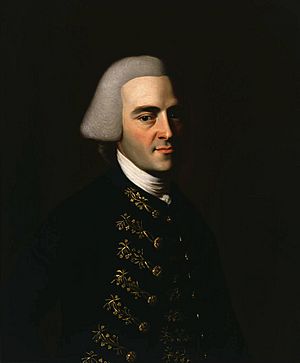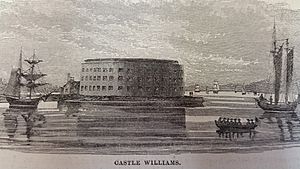Liberty Affair facts for kids
Quick facts for kids Liberty Affair |
|||
|---|---|---|---|
| Part of the American Revolution | |||
| Date | June 10, 1768 | ||
| Location | |||
| Caused by |
|
||
| Parties to the civil conflict | |||
|
|||
| Lead figures | |||
|
|||
| Number | |||
|
|||
| Casualties | |||
|
|||
The Liberty Affair was a big event in 1768 that led to a riot in Boston. It was an important step towards the Boston Massacre in 1770. This incident happened when British officials took a ship called the Liberty. The ship belonged to a rich merchant named John Hancock. Some people said he was a smuggler.
This event showed how hard it was for Britain to make its tax laws work in America. It also showed that many Americans were getting very angry with British rule. The Liberty Affair was one of many events that eventually led to the American Revolution.
Contents
What Caused the Liberty Affair?
The Liberty Affair happened on June 10, 1768. But it was sparked by something that happened earlier. In the spring of 1768, a captain named Daniel Malcolm was accused of smuggling 60 barrels of wine.
Then, on May 9, 1768, customs officials boarded one of John Hancock's ships, the Liberty. They found only 25 barrels of wine. This was much less than the ship could carry. The customs officials thought this was like the earlier smuggling case with Malcolm's wine.
The Seizure of the Liberty
At first, two customs officials inspected the Liberty and found nothing wrong. But a month later, a British warship named Romney arrived in Boston. One of the customs officials then changed his story.
Thomas Kirk, a customs collector, claimed there were about 100 barrels of wine. He said the crew unloaded most of them to avoid paying taxes. He also claimed that he was held on the ship for refusing a bribe from Hancock.
On June 10, a riot broke out. This happened after British sailors started to tow the Liberty away to the Romney. Daniel Malcolm, who was there, wrote about it in the Boston Chronicle newspaper. He said the British had illegally taken the ship.
The Riot in Boston
The crowd attacked the customshouse, which was the building where customs officials worked. The British sailors had to run away to the British warship. Then they went to Castle William.
Joseph Harrison, the chief customs collector, his son, and another official named Benjamin Hallowell were attacked by the crowd. This happened when the people failed to stop the British sailors from towing the Liberty. About 3,000 colonists took part in the riot.
The Trial and Aftermath
The British government filed a lawsuit against the Liberty and John Hancock. John Adams, who would later become a U.S. president, was hired as Hancock's lawyer. Many people saw the trial as a way to punish Hancock. He was against the Stamp Act and was a leader in Boston's Whig politics.
The trial lasted five months. In the end, the charges against Hancock were dropped. Hancock later became the president of the colonists' revolutionary government. He was also the first person to sign the American Declaration of Independence.
The Liberty ship stayed with the British Navy. It was officially taken by the British because it broke Britain's trade laws. The Liberty became a sloop (a type of sailboat) used to patrol the coast of Rhode Island. In July 1769, angry colonists burned the ship after its crew took two ships from Connecticut.
Growing Tensions
The Liberty Affair made the British Parliament pass stricter laws. They wanted to stop smuggling and send more troops to deal with the rebels in Massachusetts. Right after the riot, Governor Francis Bernard was told to find proof against the Boston riot leaders. The British wanted to put them on trial in England.
Lord Hillsborough, who was in charge of the colonies, also sent two groups of soldiers from Halifax, Nova Scotia to Boston. He also told the Massachusetts House of Representatives to cancel a letter they sent to other colonies. This letter asked for unity against the Townshend Acts, which were new taxes. If they didn't, their government would be shut down.
The House of Representatives refused the order. The names of the 92 delegates who said no were remembered on a "Liberty Bowl." This bowl was made by the silversmith Paul Revere. These actions and events made the tensions between Britain and the colonies even worse. After the riot, many events followed that led to the Boston Massacre. These events also helped unite the colonies to stop buying British goods. This was something Boston and Charleston had not been able to do before.



